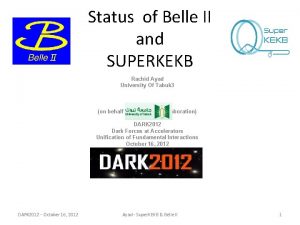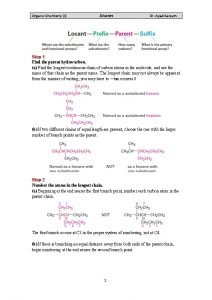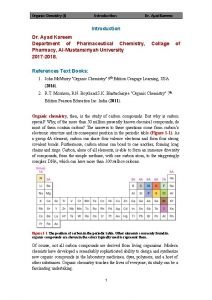Organic Chemistry I Alkanes Dr Ayad Kareem Alkanes







- Slides: 7

Organic Chemistry (I) Alkanes Dr. Ayad Kareem Alkanes are simplest family of molecules that contain the carbon– carbon single bond results from σ (head-on) overlap of carbon sp 3 hybrid orbitals. Alkanes are often described as saturated hydrocarbons: hydrocarbons because they contain only carbon and hydrogen; saturated because they have only C-C and C-H single bonds and thus contain the maximum possible number of hydrogens per carbon. They have the general formula Cn. H 2 n+2, where n is an integer. Alkanes are also occasionally called aliphatic compounds. Think about the ways that carbon and hydrogen might combine to make alkanes. With one carbon and four hydrogens, only one structure is possible: methane, CH 4. Similarly, there is only one combination of two carbons with six hydrogens (ethane, CH 3) and only one combination of three carbons with eight hydrogens (propane, CH 3 CH 2 CH 3). When larger numbers of carbons and hydrogens combine, however, more than one structure is possible. For example, there are two substances with the formula C 4 H 10: the four carbons can all be in a row (butane), or they can branch (isobutane). Similarly, there are three C 5 H 12 molecules, and so on for larger alkanes. 1

Organic Chemistry (I) Alkanes Dr. Ayad Kareem Compounds like butane and pentane, whose carbons are all connected in a row, are called straight-chain alkanes, or normal alkanes. Compounds like 2 -methylpropane (isobutane), 2 -methylbutane, and 2, 2 -dimethylpropane, whose carbon chains branch, are called branched-chain alkanes. Compounds like the two C 4 H 10 molecules and the three C 5 H 12 molecules, which have the same formula but different structures, are called isomers, from the Greek isos + meros, meaning ―made of the same parts. ‖ Isomers are compounds that have the same numbers and kinds of atoms but differ in the way the atoms are arranged. Compounds like butane and isobutane, whose atoms are connected differently, are called constitutional isomers. We’ll see shortly that other kinds of isomers are also possible, even among compounds whose atoms are connected in the same order. As Table 3 -2 shows, the number of possible alkane isomers increases dramatically with the number of carbon atom 2

Organic Chemistry (I) Alkanes Dr. Ayad Kareem Constitutional isomerism is not limited to alkanes it occurs widely throughout organic chemistry. Constitutional isomers may have different carbon skeletons (as in isobutane and butane), different functional groups (as in ethanol and dimethyl ether), or different locations of a functional group along the chain (as in isopropylamine and propylamine). Regardless of the reason for the isomerism, constitutional isomers are always different compounds with different properties but with the same formula. A given alkane can be drawn in many ways. For example, the straight chain, fourcarbon alkane called butane can be represented by any of the structures shown in Figure 3 -2. These structures don’t imply any particular three-dimensional geometry for butane; they indicate only the connections among atoms. In practice, chemists rarely draw all the bonds in a molecule and usually refer to butane by the condensed structure, CH 3 CH 2 CH 3 or CH 3(CH 2)2 CH 3. Still more simply, butane can be represented as n-C 4 H 10, where n denotes normal (straight-chain) butane. 3

Organic Chemistry (I) Alkanes Dr. Ayad Kareem Figure 3 -2 some representations of butane, C 4 H 10. The molecule is the same regardless of how it’s drawn. These structures imply only that butane has a continuous chain of four carbon atoms; they do not imply any specific geometry. Straight-chain alkanes are named according to the number of carbon atoms they contain, as shown in Table 3 -3. With the exception of the first four compounds (methane, propane, and butane) whose names have historical roots, the alkanes are named based on Greek numbers. The suffix -ane is added to the end of each name to indicate that the molecule identified is an alkane. Thus, pentane is the five-carbon alkane; hexane is the six carbon alkane, and so on. We’ll soon see that these alkane names form the basis for naming all other organic compounds, so at least the first ten should be memorized. Alkyl Groups If you imagine removing a hydrogen atom from an alkane, the partial structure that remains is called an alkyl group. Alkyl groups are not stable compounds themselves; they are simply parts of larger compounds. Alkyl groups are named by replacing the ane ending of the parent alkane with an -yl ending. For example, removal of hydrogen from methane, CH 4, generates a methyl group, CH 3, and removal of hydrogen from ethane, CH 3, generates an ethyl group, CH 2 CH 3. Similarly, removal of a hydrogen atom from the end carbon of any straightchain alkane gives the series of straight-chain alkyl groups shown in Table 3 -4. 4

Organic Chemistry (I) Alkanes Dr. Ayad Kareem Combining an alkyl group with any of the functional groups listed earlier makes it possible to generate and name many thousands of compounds. For example: Just as straight-chain alkyl groups are generated by removing hydrogen from an end carbon, branched alkyl groups are generated by removing a hydrogen atom from an internal carbon. Two 3 -carbon alkyl groups and four 4 -carbon alkyl groups are possible (Figure 3 -3). Figure 3 -3 Alkyl groups generated from straight-chain alkanes. One further comment about naming alkyl groups: the prefixes sec- (for secondary) and tert- (for tertiary) used for the C 4 alkyl groups in Figure 3 -3 refer to the number of other carbon atoms attached to the branching carbon atom. There are four possibilities: primary (1°), secondary (2°), tertiary (3°), and quaternary (4°). 5

Organic Chemistry (I) Alkanes Dr. Ayad Kareem The symbol R is used here and throughout organic chemistry to represent a generalized organic group. The R group can be methyl, propyl, or any of a multitude of others. You might think of R as representing the Rest of the molecule, which isn’t specified. The terms primary, secondary, tertiary, and quaternary are routinely used in organic chemistry, and their meanings need to become second nature. For example, if we were to say, ―Citric acid is a tertiary alcohol, ‖ we would mean that it has an alcohol functional group (-OH) bonded to a carbon atom that is itself bonded to three other carbons. In addition, we also speak of hydrogen atoms as being primary, secondary, or tertiary. Primary hydrogen atoms are attached to primary carbons (RCH 3), secondary hydrogens are attached to secondary carbons (R 2 CH 2), and tertiary hydrogens are attached to tertiary carbons (R 3 CH). There is, of course, no such thing as quaternary hydrogen. Naming Alkanes A chemical name typically has four parts in the IUPAC system of nomenclature: prefix, parent, locant, and suffix. The prefix identifies the various substituent groups in the molecule, the parent selects a main part of the molecule and tells how many carbon atoms are in that part, the locants give the positions of the functional groups and substituents, and the suffix identifies the primary functional group. 6

Organic Chemistry (I) Alkanes Dr. Ayad Kareem Step 1 Find the parent hydrocarbon. (a) Find the longest continuous chain of carbon atoms in the molecule, and use the name of that chain as the parent name. The longest chain may not always be apparent from the manner of writing; you may have to ―turn corners. ‖ (b) If two different chains of equal length are present, choose the one with the larger number of branch points as the parent. Step 2 Number the atoms in the longest chain. (a) Beginning at the end nearer the first branch point, number each carbon atom in the parent chain. The first branch occurs at C 3 in the proper system of numbering, not at C 4. (b) If there is branching an equal distance away from both ends of the parent chain, begin numbering at the end nearer the second branch point. 7













